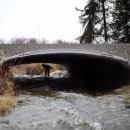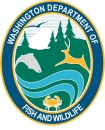States
WashingtonIn the Pacific Northwest the West Fork Grays River Fish Passage project will work with the Cowlitz Indian Tribe to remove derelict water intake infrastructure. The water intake structure was constructed in 1961 with a channel spanning concrete dam and steel weir that directed water flow from the West Fork Grays River into a screened intake. Recent fish passage surveys documented the intake as a severe partial barrier with a 33% passbility rating due to high velocities, turbulence and period it low flows. The Cowlitz Indian Tribe proposes to utilize the recently completed West Fork Grays Design to facilitate the removal the weir and surrounding concrete infrastructure and replace the disturbed areas with an apex log jam to restore natural processes, attenuate sediment, scour a deep pool, create habitat complexity and provide perennial flow to the diversion side channel. The intake removal will also restore fish passage to over 15 miles of upstream spawning and rearing habitat. This project will benefit federally listed (threatened) Grays River populations of winter steelhead, coho, fall Chinook, and chum salmon.
Quick Facts:
| Project Status | In Development |
| Location | WA, Pacific |
| NFPP Project Funding | $99,800 |
| Restoration Techniques | Weir Removal |
| Accomplishments | 15 Stream Miles Reopened |
| Project Partner Lead | Cowlitz Indian Tribe |
| Primary Species Benefited | Fall Chinook Salmon |
The National Fish Passage Program combines technical expertise with a track record of success.
Implemented primarily through the Service's Fish and Wildlife Conservation Offices, the National Fish Passage Program provides financial and technical assistance to partners across the country. Since 1999, the program has worked with over 2,000 local communities, Tribes, and private landowners to remove or bypass over 3,400 barriers to fish passage and reopen access to over 61,000 miles of upstream habitat for fish and other animals. Staff have expertise in fish migration and biology as well as financial, engineering, and planning assistance to communities, Tribes, and landowners to help them remove barriers and restore rivers for the benefit both fish and people.
Fish passage project proposals can be initiated by any individual, organization, government, or agency. However, proposals must be submitted and completed in cooperation with a Fish and Wildlife Conservation Office. (Please note that fish passage projects being used for federal or state compensatory mitigation or required by existing federal or state regulatory programs are not eligible for funding through the National Fish Passage Program.)
Contact a fish passage coordinator in your area to get started











